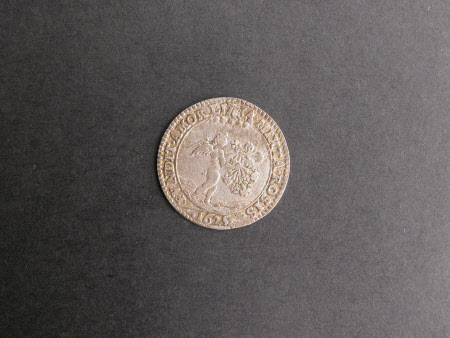The marriage of Charles I and Henrietta Maria
Pierre Regnier (c. 1577-1640)
Category
Coins and medals
Date
Unknown
Materials
Silver
Measurements
222 mm (Diameter)
Place of origin
Paris
Order this imageCollection
Osterley Park and House, London
NT 773245
Summary
Silver, medal commemorating the marriage of Charles I and Henrietta Maria, Pierre Regnier (c. 1577-1640), Paris, 1625. A small silver medal by Pierre Regnier commemorating the marriage of King Charles I (1600-1649) and Henrietta Maria (1609-1669), daughter of King Henri IV of France, on 13 June 1625. The obverse shows the king and queen in profile, facing each other, Charles bare-headed and wearing a ruff and the Order of the Garter on a ribbon around his neck. The queen wears a dress with a stiff ruff; her hair is bejewelled and she wears ear-rings and a necklace. The Latin legend translates as ‘Charles the Great, and Henrietta Maria, King and Queen of Britain.’ On the reverse is the figure of Cupid walking and scattering roses and lilies whilst, above in the sky, may be seen rays from heaven. The legend translates as ‘Love pours out lilies mingled with roses’ and the exergue carries the date, 1625. The medal was commissioned by Henrietta Maria’s brother King Louis XIII of France.
Full description
Henrietta Maria was born on 25 November 1609, the youngest child of King Henri IV of France and his Italian second wife, Maria de’Medici. When Henrietta Maria was less than a year old, her father was assassinated by a Catholic fanatic. Her mother, after acting as Regent for seven years, was banished from the court in 1617 by Henrietta’s brother, King Louis XIII. The strong Catholic faith in which Henrietta Maria was brought up would guide her subsequent life, also seriously affecting her popularity among her largely Protestant subjects in Britain. Henrietta Maria and Charles I were married shortly after Charles had acceded to the throne on the death of his father King James I/VI. The young couple – he was 24 and she just 15 – were married by proxy on 11 May 1625 and, in person, at St. Augustine's Church, Canterbury, on 13 June 1625. The small medal was commissioned by King Louis XIII at the time of the proxy wedding, from the French medallist Pierre Regnier, to celebrate the wedding of his sister. A document of 12 May 1625 records that the medals were made in the first event for distribution to members of the court (Mazerolle, Les médailleurs français, I, p. 272, doc. 353). Surviving examples vary in their weight, technique and details, some versions showing Charles in a falling collar rather than a ruff. It is very likely that the medal was widely reproduced both in France and in England. The medal has been described as ‘a charming jeton, remarkable in its artistry (‘Charmant jeton, d’un art remarquable.’ Feuardent, Jetons, p. 72). The reverse, with Cupid scattering lilies and roses, the national flowers respectively of France and England, alludes gracefully to the dynastic alliance between Britain and France created by the marriage. The charming legend, ‘Love pours out lilies mingled with roses’, is based on a line from the Latin poet Virgil’s Aeneid, ‘or white lilies blush when mingled with many a rose’ (‘aut mixta rubent ubi lilia multa alba rosa’). Although the marriage between Charles and Henrietta did not start very well, after the assassination in 1628 of the royal favourite, the Duke of Buckingham, the couple became ever closer and they eventually had nine children. Henrietta Maria’s overt Catholic sympathies and her political meddling played their part in the drift during the 1630s towards conflict between the monarch and Parliament, which would eventually lead to the Civil War. Jeremy Warren 2019
Provenance
Given to the National Trust in 1993 by George Child Villiers, 9th Earl of Jersey (1910-1998).
Marks and inscriptions
Obverse, legend: CH. MAG. ET. HEN. MA. BRIT. REX. ET. REG. Reverse, legend: FVNDIT. AMOR. LILIA. MIXTA. ROSIS. Reverse, exergue: 1625.
Makers and roles
Pierre Regnier (c. 1577-1640), medallist
References
Hawkins, Franks and Grueber 1885: Edward Hawkins, Augustus W. Franks and Herbert A. Grueber (eds.), Medallic Illustrations of the History of Great Britain and Ireland to the death of George II, 2 vols., London 1885, vol. I, p. 238, no. 1. Mazerolle 1902-04: Fernand Mazerolle, Les médailleurs français du XVe siècle au milieu du XVIIe, 3 vols., Paris 1902-1904, vol. II, p. 101, no. 491. Feuardent 1904: Félix Feuardent, Jetons et méreaux depuis Louis IX jusqu'à la fin du consulat de Bonaparte. I. Grandes administrations de l'État et de la ville de Paris, corporations, etc., noblesse et villes de l'Ile-de-France, Paris 1904, p. 72, no. 12036. Jones 1988: Mark Jones, A Catalogue of the French Medals in the British Museum. II. 1600-1672, London 1988, pp. 139-40, nos. 101-06. Mitchiner 1988-2007: Michael Mitchiner, Jetons, Medalets and Tokens, 4 vols., London 1988-2007, vol. III (British Isles circa 1588 to 1830), 1998, p. 1613, no. 71.3 (4515). Eimer 2010: Christopher Eimer, British Commemorative Medals and their Values, London 2010, p.42, no. 105A, pl. 10. Platt 2013: Jerome J. Platt and Arleen Kay Platt, The English Civil Wars: Medals, Historical Commentary & Personalities, 2 vols., London 2013, vol. I, pp. 115-16.
